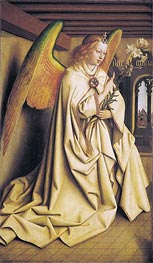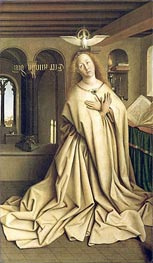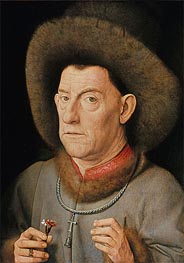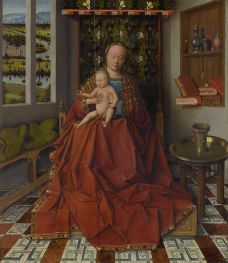
Jan van Eyck Painting Reproductions 2 of 2
b.1395-1441
Netherlandish Northern Renaissance Painter
42 Jan van Eyck Paintings

The Knights of Christ (The Ghent Altarpiece) 1432
Oil Painting
$6648
$6648
Canvas Print
$64.32
$64.32
SKU: EJV-7861
Jan van Eyck
Original Size: unknown
Saint Bavo Cathedral, Ghent, Belgium
Jan van Eyck
Original Size: unknown
Saint Bavo Cathedral, Ghent, Belgium

The Hermits (The Ghent Altarpiece) 1432
Oil Painting
$4757
$4757
Canvas Print
$64.32
$64.32
SKU: EJV-7862
Jan van Eyck
Original Size: unknown
Saint Bavo Cathedral, Ghent, Belgium
Jan van Eyck
Original Size: unknown
Saint Bavo Cathedral, Ghent, Belgium

The Pilgrims (The Ghent Altarpiece) 1432
Oil Painting
$4496
$4496
Canvas Print
$64.32
$64.32
SKU: EJV-7863
Jan van Eyck
Original Size: unknown
Saint Bavo Cathedral, Ghent, Belgium
Jan van Eyck
Original Size: unknown
Saint Bavo Cathedral, Ghent, Belgium

The Adoration of the Mystic Lamb (The Ghent Altarpiece) 1432
Oil Painting
$31656
$31656
Canvas Print
$64.32
$64.32
SKU: EJV-7864
Jan van Eyck
Original Size: 137.7 x 242.3 cm
Saint Bavo Cathedral, Ghent, Belgium
Jan van Eyck
Original Size: 137.7 x 242.3 cm
Saint Bavo Cathedral, Ghent, Belgium

The Angel Gabriel passes the Message to Maria ... 1432
Oil Painting
$2839
$2839
Canvas Print
$64.32
$64.32
SKU: EJV-7865
Jan van Eyck
Original Size: unknown
Saint Bavo Cathedral, Ghent, Belgium
Jan van Eyck
Original Size: unknown
Saint Bavo Cathedral, Ghent, Belgium

Virgin Annunciate (The Ghent Altarpiece) 1432
Oil Painting
$3083
$3083
Canvas Print
$64.32
$64.32
SKU: EJV-7866
Jan van Eyck
Original Size: unknown
Saint Bavo Cathedral, Ghent, Belgium
Jan van Eyck
Original Size: unknown
Saint Bavo Cathedral, Ghent, Belgium

John the Baptist (The Ghent Altarpiece) 1432
Oil Painting
$1944
$1944
Canvas Print
$64.32
$64.32
SKU: EJV-7867
Jan van Eyck
Original Size: unknown
Saint Bavo Cathedral, Ghent, Belgium
Jan van Eyck
Original Size: unknown
Saint Bavo Cathedral, Ghent, Belgium

The Apostle John (The Ghent Altarpiece) 1432
Oil Painting
$1918
$1918
Canvas Print
$64.32
$64.32
SKU: EJV-7868
Jan van Eyck
Original Size: unknown
Saint Bavo Cathedral, Ghent, Belgium
Jan van Eyck
Original Size: unknown
Saint Bavo Cathedral, Ghent, Belgium

Judocus Vyd (The Ghent Altarpiece) 1432
Oil Painting
$2306
$2306
Canvas Print
$64.32
$64.32
SKU: EJV-7869
Jan van Eyck
Original Size: unknown
Saint Bavo Cathedral, Ghent, Belgium
Jan van Eyck
Original Size: unknown
Saint Bavo Cathedral, Ghent, Belgium

Lysbette Borluut (The Ghent Altarpiece) 1432
Oil Painting
$2343
$2343
Canvas Print
$64.32
$64.32
SKU: EJV-7870
Jan van Eyck
Original Size: unknown
Saint Bavo Cathedral, Ghent, Belgium
Jan van Eyck
Original Size: unknown
Saint Bavo Cathedral, Ghent, Belgium

The Crucifixion n.d.
Canvas Print
$64.32
$64.32
SKU: EJV-7871
Jan van Eyck
Original Size: 46 x 31 cm
Galleria G. Franchetti alla Ca' d'Oro, Venice, Italy
Jan van Eyck
Original Size: 46 x 31 cm
Galleria G. Franchetti alla Ca' d'Oro, Venice, Italy

Adam (The Ghent Altarpiece) 1432
Oil Painting
$1971
$1971
Canvas Print
$64.32
$64.32
SKU: EJV-15726
Jan van Eyck
Original Size: unknown
Saint Bavo Cathedral, Ghent, Belgium
Jan van Eyck
Original Size: unknown
Saint Bavo Cathedral, Ghent, Belgium

Eve (The Ghent Altarpiece) 1432
Oil Painting
$1989
$1989
Canvas Print
$64.32
$64.32
SKU: EJV-15727
Jan van Eyck
Original Size: unknown
Saint Bavo Cathedral, Ghent, Belgium
Jan van Eyck
Original Size: unknown
Saint Bavo Cathedral, Ghent, Belgium

Jan de Leeuw, Goldsmith 1436
Oil Painting
$1674
$1674
Canvas Print
$64.32
$64.32
SKU: EJV-15728
Jan van Eyck
Original Size: 24.6 x 19.2 cm
Kunsthistorisches Museum, Vienna, Austria
Jan van Eyck
Original Size: 24.6 x 19.2 cm
Kunsthistorisches Museum, Vienna, Austria

Gonella (The Court Dwarf of the Dukes of Ferrara) n.d.
Oil Painting
$1798
$1798
Canvas Print
$64.32
$64.32
SKU: EJV-15729
Jan van Eyck
Original Size: 36 x 24 cm
Kunsthistorisches Museum, Vienna, Austria
Jan van Eyck
Original Size: 36 x 24 cm
Kunsthistorisches Museum, Vienna, Austria

Man with Pinks n.d.
Oil Painting
$1921
$1921
Canvas Print
$64.32
$64.32
SKU: EJV-15730
Jan van Eyck
Original Size: 41.5 x 31.5 cm
Gemaldegalerie, Berlin, Germany
Jan van Eyck
Original Size: 41.5 x 31.5 cm
Gemaldegalerie, Berlin, Germany

The Three Marys at the Tomb c.1425/35
Oil Painting
$3730
$3730
Canvas Print
$77.26
$77.26
SKU: EJV-15731
Jan van Eyck
Original Size: 71.5 x 90 cm
Museum Boijmans Van Beuningen, Rotterdam, Netherlands
Jan van Eyck
Original Size: 71.5 x 90 cm
Museum Boijmans Van Beuningen, Rotterdam, Netherlands

Virgin and Child in an Interior c.1450
Oil Painting
$3954
$3954
Canvas Print
$84.53
$84.53
SKU: EJV-19793
Jan van Eyck
Original Size: 59 x 51 cm
Groeninge Museum, Bruges, Belgium
Jan van Eyck
Original Size: 59 x 51 cm
Groeninge Museum, Bruges, Belgium